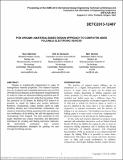| dc.contributor.author | Sterman, Yoav | |
| dc.contributor.author | Demaine, Erik D | |
| dc.contributor.author | Oxman, Neri | |
| dc.date.accessioned | 2021-11-24T19:09:51Z | |
| dc.date.available | 2021-11-08T20:00:40Z | |
| dc.date.available | 2021-11-24T19:09:51Z | |
| dc.date.issued | 2013-08 | |
| dc.identifier.uri | https://hdl.handle.net/1721.1/137808.2 | |
| dc.description.abstract | Origami is traditionally implemented in paper of homogeneous material properties. This research explores the use of material with embedded electronics such as PCB (Printed Circuit Boards) as the medium for origami folding in order to create an interactive folding experience and to generate foldable objects with added functionalities. PCBs are produced as 2D shapes. By folding PCB arrays it is possible to create 3D objects that contain electronic functions. Conductivity, output devices (such as Light Emitting Diodes) and microcontroller computation can create an interactive folding experience, for user guidance and verification of the folding. We call this approach and methodology PCB Origami. The work presented in this paper describes two unique interaction and fabrication techniques for creating and folding electronic materials. We demonstrate prototypes and present verification/evaluation strategies for guiding the user through the folding process. Copyright © 2013 by ASME. | en_US |
| dc.language.iso | en | |
| dc.publisher | American Society of Mechanical Engineers | en_US |
| dc.relation.isversionof | 10.1115/detc2013-12497 | en_US |
| dc.rights | Article is made available in accordance with the publisher's policy and may be subject to US copyright law. Please refer to the publisher's site for terms of use. | en_US |
| dc.source | ASME | en_US |
| dc.title | PCB Origami: A Material-Based Design Approach to Computer-Aided Foldable Electronic Devices | en_US |
| dc.type | Article | en_US |
| dc.identifier.citation | Sterman, Yoav, Demaine, Erik D. and Oxman, Neri. 2013. "PCB Origami: A Material-Based Design Approach to Computer-Aided Foldable Electronic Devices." | en_US |
| dc.contributor.department | Massachusetts Institute of Technology. Media Laboratory | en_US |
| dc.contributor.department | Massachusetts Institute of Technology. Computer Science and Artificial Intelligence Laboratory | en_US |
| dc.contributor.department | Massachusetts Institute of Technology. Department of Electrical Engineering and Computer Science | en_US |
| dc.eprint.version | Final published version | en_US |
| dc.type.uri | http://purl.org/eprint/type/ConferencePaper | en_US |
| eprint.status | http://purl.org/eprint/status/NonPeerReviewed | en_US |
| dc.date.updated | 2019-06-20T11:57:39Z | |
| dspace.date.submission | 2019-06-20T11:57:40Z | |
| mit.license | PUBLISHER_POLICY | |
| mit.metadata.status | Publication Information Needed | en_US |
